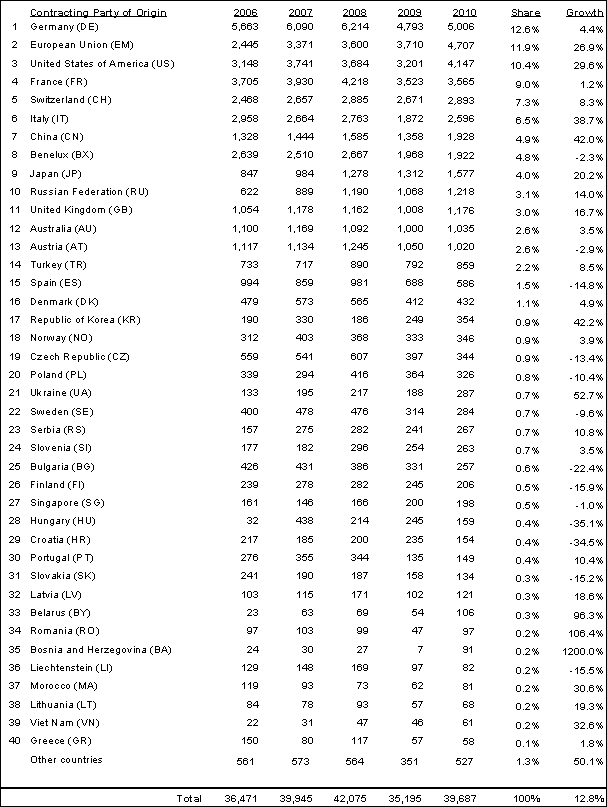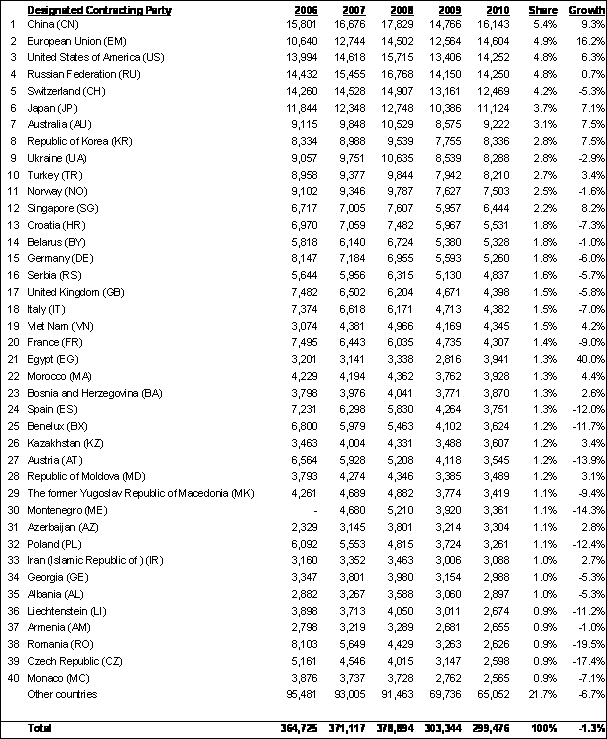International Trademark Filings Recover in 2010
Geneva,
April 4, 2011
PR/2011/685
International trademark activity recovered in 2010 with WIPO receiving 39,687 applications under the 85-member Madrid System for the International Registration of Trademarks (“the Madrid system”), representing a 12.8% rate of growth1. The largest growth was registered from the Republic of Korea (+42.2%), China (+42%), Italy (+38.7%), United States of America (+29.6%), European Union (+26.9%) and Japan (+20.2%).
Similarly, international trademark registrations were up 4.5% on 2009 with a total 37,533 international registrations in 2010. WIPO recorded 21,949 international trademark renewals in 2010, representing an increase of 14.1%, reflecting the value of established brands at a time when consumers opt for goods that are tried and trusted.
“International trademark activity has rebounded and has nearly recovered the ground lost in 2009,” said WIPO Director General Francis Gurry.
Regional and National Filing Trends (table 1)
The EU accounted for over half of the international applications received – some 22,403 - in 2010. This includes international applications filed through national trademark offices of the countries concerned and those filed through the Office of Harmonization for the Internal Market (OHIM)2. Some 4,707 international applications were filed through OHIM in 2010 representing a 26.9% increase on figures for 2009.
Among major users, applicants in Germany ranked first, filing 5,006 international applications, representing 12.6% of the total. OHIM ranked second with 4,707 international applications reflecting a 26.9% increase on 2009 figures. Applicants based in the USA accounted for 4,147 international applications, representing 10.4% of the total. USA moved up one place to become the third largest filer. France ranked 4th (from 3rd) with 3,565 applications or 9.0% of the total. Switzerland held its 5th ranking with 2,893 international applications, and an increase of 8.3 %, followed by Italy, China and the Benelux countries (Belgium, Luxembourg and the Netherlands). Significant movement in rankings was seen for the Republic of Korea (from 23rd to 17th) and Ukraine (from 29th to 21st). Detailed information is available in the table below.
Top Holders and Top Applicants
With 137 international trademark applications, Philip Morris (Switzerland) was the largest filer in 2010 followed by Novartis (Switzerland), Boehringer Ingelheim (Germany), Da Lian Ya Tu Tou Zi Zi Xun You Xian Gong Si (China), Ministero Delle Politiche Agricole (Italy), Zhejiang Chengpeng Industry (China), KRKA (Slovenia), Henkel (Germany), Novo Nordisk (Denmark), Nestlé (Switzerland), Galenka (Serbia), Janssen Pharmaceutica (Belgium), BSH Bosch und Siemens (Germany), Syngenta (Switzerland ), Glaxo Group (UK), Biofarma (France), Egis Gyógyszergyár (Hungary), EkoSan (Bosnia and Herzegovina) , Apple Inc (USA) and Phillips (Netherlands).
Henkel (Germany), with a total of 2,973, holds the largest number of international trademark registrations under the Madrid system. The top twenty holders by the end of 2010 were: Henkel (Germany), Novartis (Switzerland), Janssen Pharmaceutica (Belgium), l’Oréal (France), Nestlé (Switzerland), Unilever (Netherlands), Sanofi-Aventis (France), BASF (Germany), ITM Enterprises (France), ), Lidl (Germany), Siemens (Germany), Bayer (Germany), Biofarma (France), Boehringer Ingelheim (Germany), Richter Gedeon (Hungary), Syngenta (Switzerland), Philips (Netherlands), Deutsche Telekom (Germany), Merck (Germany), and Ecolab (Germany).
Top Designated Countries (table 2)
Madrid Union members were notified of 299,476 new designations (contained in new registrations or territorial extensions) in 2010, representing a 1.3% decrease compared to 2009. The likely reason for such a decrease is that many applicants prefer making a single designation of the European Union as a whole instead of designating individual Member States of the European Union.
When submitting an international trademark application, applicants must designate those member states in which they want their mark to be protected. Applicants can also extend the effects of an international registration to other members at a later date by filing a subsequent designation. In this way, the holder of an international registration can expand the geographical scope of the protection of a mark in line with evolving business needs.
The top six in the ranking of most designated member states changed in 2010. China (with 16,143 designations) continues to be the most designated country, but the European Union moved up three places to become 2nd , followed by the USA, Russian Federation (from 2nd to 4th), Switzerland and Japan.
A number of countries moved up the list of 40 most designated contracting parties. For example, the Republic of Korea moved from 10th to 8th position, Egypt from 39th to 21st position, Morocco from 27th to 22nd position, Bosnia and Herzegovina from 26th to 23rd position, Kazakhstan from 29th to 26th position, Republic of Moldova from 30th to 28th position and the Islamic Republic of Iran (from 37th to 33th position). One new country entered the top 40 most designated countries in 2010, namely, Armenia (from 42nd to 37th).
Profile of Registrations Recorded in 2010
In submitting a trademark application, an applicant has to specify the goods or services to which the trademark will be applied in accordance with an international classification system known as the “Nice Classification”. The most popular classes of goods and services in international trademark registrations recorded in 2010 were Class 9 (covering, for example, computer hardware and software) representing 8.5% of the total, Class 35 (covering services such as office functions, advertising and business management) which represented 7% of the total, Class 25 (covering clothing, footwear and headgear) which represented 5.4% of the total, Class 42 (covering services provided by for example, scientific, industrial or technological engineers and computer specialists) which represented 5.2% of the total; Class 5 (covering mainly pharmaceuticals and other preparations for medical purposes) which represented 5.1% of the total, and Class 41 (covering services in the area of education, training, entertainment, sporting and cultural activities) which represented 4.4% of the total.
WIPO recently launched the “Goods and Services Manager,” which helps trademark applicants in compiling the list of goods and services that must be submitted when filing an international application under the Madrid System.
Active International Registrations
Over half a million (526,674) international registrations were active in the International Register at the end of 2010, containing some 5.55 million active designations and representing a 2.2% increase relative to 2009. These registrations belong to 174,349 right holders who are mostly small and medium-sized enterprises.
General Information about the Madrid System
The WIPO-administered Madrid System for the International Registration of Marks offers a trademark owner the possibility of having a mark protected in up to 85 countries by filing one application, in one language (English, French or Spanish), with one set of fees, in one currency (Swiss Francs). Applicants wishing to use the Madrid system must apply for trademark protection in a relevant national or regional trademark office before seeking international protection. An international registration under the Madrid system produces the same effects as an application for registration of the mark in each of the contracting parties designated by the applicant. If protection is not refused by the trademark office of a designated contracting party, the status of the mark is the same as if it had been registered by that office. Thereafter, the international registration can be maintained and renewed through a single procedure. Thus, the system provides a cost-effective and efficient way for trademark holders to secure and maintain protection for their marks in multiple countries.
The oldest international trademark registration which is still in effect as a result of multiple renewals, belongs to Swiss watchmaker Longines. This trademark was first registered in 1893. The international register is located at WIPO’s Geneva headquarters.
Trademarks are a key component of any successful business marketing strategy as they allow companies to identify, promote and license their goods or services in the marketplace and to distinguish them from those of their competitors, and cement customer loyalty. A trademark symbolizes the promise of a quality product and in today’s global and increasingly electronic marketplace, a trademark is often the only way for customers to identify a company’s products and services. Trademark protection hinders moves to “free ride” on the goodwill of a company by using similar distinctive signs to market inferior or similar products or services. Loss, dilution or infringement of a high-value trademark could prove devastating to a business.
ANNEXES
Table 1 - Major Filing Contracting Parties
Number of applications filed by Contracting Party
Shares within total filings in 2010 and growth rates as compared to 2009

Table 2 - Most Designated Contracting Parties
Number of designations by designated Contracting Party (Includes designations in new registrations and subsequent designations)
Shares within total filings in 2010 and growth rates as compared to 2009

List of Members of the Madrid Union (85)
| Albania (A&P) | Hungary (A&P) | Republic of Moldova (A&P) |
| Algeria (A) | Iceland (P) | Romania (A&P) |
| Antigua and Barbuda (P) | Iran (Islamic Republic of) (A&P) | Russian Federation (A&P) |
| Armenia (A&P) | Ireland (P) | San Marino (A&P) |
| Australia (P) | Israel (P) | Sao Tome and Principe (P) |
| Austria (A&P) | Italy (A&P) | Serbia (A&P) |
| Azerbaijan (A&P) | Japan (P) | Sierra Leone (A&P) |
| Bahrain (P) | Kazakhstan (A&P) | Singapore (P) |
| Belarus (A&P) | Kenya (A&P) | Slovakia (A&P) |
| Belgium* (A&P) | Kyrgyzstan (A&P) | Slovenia (A&P) |
| Bhutan (A&P) | Latvia (A&P) | Spain (A&P) |
| Bosnia and Herzegovina (A&P) | Lesotho (A&P) | Sudan (A&P) |
| Botswana (P) | Liberia (A&P) | Swaziland (A&P) |
| Bulgaria (A&P) | Liechtenstein (A&P) | Sweden (P) |
| China (A&P) | Lithuania (P) | Switzerland (A&P) |
| Croatia (A&P) | Luxembourg* (A&P) | Syrian Arab Republic (A&P) |
| Cuba (A&P) | Madagascar (P) | Tajikistan (A) |
| Cyprus (A&P) | Monaco (A&P) | The former Yugoslav Republic of |
| Czech Republic (A&P) | Mongolia (A&P) | Macedonia (A&P) |
| Democratic People’s | Montenegro (A&P) | Turkey (P) |
| Republic of Korea (A&P) | Morocco (A&P) | Turkmenistan (P) |
| Denmark (P) | Mozambique (A&P) | Ukraine (A&P) |
| Egypt (A&P) | Namibia (A&P) | United Kingdom (P) |
| Estonia (P) | Netherlands: | United States of America (P) |
| European Union (P) | – Territory in Europe* (A&P) | Uzbekistan (P) |
| Finland (P) | – Antilles** (P) | Viet Nam (A&P) |
| France (A&P) | Norway (P) | Zambia (P) |
| Georgia (P) | Oman (P) | |
| Germany (A&P) | Poland (A&P) | |
| Ghana (P) | Portugal (A&P) | |
| Greece (P) | Republic of Korea (P) |
(A): indicates a party to the Agreement (56)
(P): indicates a party to the Protocol (83)
* Belgium, Luxembourg and the territory of the Kingdom of the Netherlands in Europe have a unified legislation on trademarks and a common Office for the registration of trademarks under that legislation (Benelux Office). Under the Madrid system, protection shall be requested as if they were one country (Benelux). Their designation shall be subject to payment of a single complementary or individual fee.
** The Netherlands Antilles is a territory of the Kingdom of the Netherlands to which Benelux Trademark law does not apply, but which has its own trademark law and its own Office for the registration of trademarks under that law. Protection in respect of the Netherlands Antilles shall be requested through a specific designation under the Protocol, distinct from that of the Benelux.
_____________________
1 Among contracting parties where more than 200 applications were filed
2 Applicants from the EU may opt to file through their national office or through OHIM
- Tel: (+41 22) 338 81 61 / 338 72 24